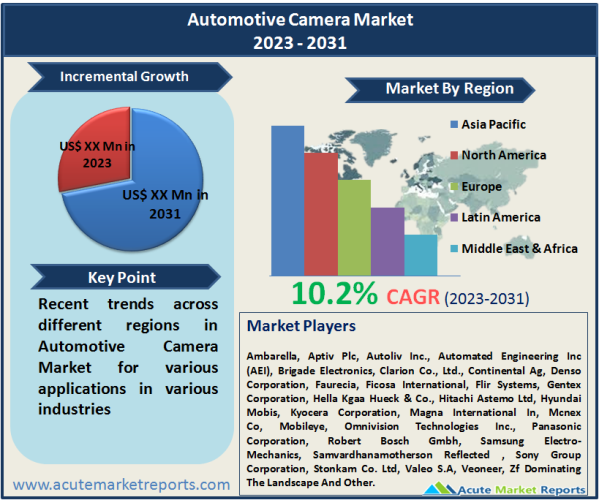
Automotive cameras, also known as car cameras or vehicle cameras, are specialized electronic devices designed for use in automobiles. These cameras are integrated into various parts of a vehicle to capture visual information from the vehicle's surroundings. They have become increasingly common in modern automobiles and serve a variety of purposes related to safety, convenience, and functionality.Automotive camera market is estimated to increase at a CAGR of 10.2% from 2025 to 2033. The global automotive camera market has been experiencing significant growth in recent years, driven by various factors such as advancements in technology, increasing safety concerns, and the rising demand for autonomous vehicles.

Advancements in Automotive Safety Systems
One of the primary drivers of the automotive camera market is the continuous advancement in automotive safety systems. With a growing emphasis on passenger and pedestrian safety, automakers are increasingly integrating camera-based systems into vehicles to provide features such as lane departure warning, adaptive cruise control, and collision avoidance. These systems rely on cameras to gather real-time data about the vehicle's surroundings, enabling them to make split-second decisions and assist the driver in avoiding accidents. For example, forward-view cameras, which are commonly mounted on the front grille, provide a clear view of the road ahead and help in recognizing potential obstacles or hazards. This technology not only enhances safety but also contributes to the development of autonomous driving capabilities.
The adoption of advanced safety systems has been witnessed in the increased installation of forward-view cameras in modern vehicles, with the expectation that these cameras will become standard features in the near future across various vehicle segments. Furthermore, regulatory bodies such as the National Highway Traffic Safety Administration (NHTSA) in the United States have been pushing for the inclusion of such systems as a part of their vehicle safety standards.
Rising Consumer Demand for Advanced Driver Assistance Systems
Consumer demand for advanced driver assistance systems (ADAS) is another significant driver propelling the automotive camera market. ADAS features, which include parking assistance, blind-spot monitoring, and lane-keeping assist, rely heavily on camera-based technologies to function effectively. Consumers are increasingly prioritizing these features when purchasing vehicles due to the added convenience and safety they offer. As a result, automakers are incorporating more cameras into their vehicle designs to meet this growing demand. Side-mirror cameras, for instance, aid in reducing blind spots, enhancing overall visibility, and improving parking maneuvers.
Legislative Initiatives and Regulations Promoting Safety
Legislative initiatives and government regulations aimed at improving road safety have played a crucial role in driving the automotive camera market. Various countries and regions have introduced stringent safety norms that require the inclusion of specific safety features in vehicles. For instance, Euro NCAP (European New Car Assessment Programme) has made it mandatory for new vehicles to have advanced safety systems, including cameras, to achieve high safety ratings. Such regulations have pushed automakers to integrate cameras not only for safety but also for meeting compliance requirements. The adoption of camera-based systems in vehicles can be directly linked to regulatory mandates and safety standards imposed by governments worldwide. These regulations have spurred investments by automotive manufacturers in camera technology, leading to increased market growth.
Cost Constraints
While the adoption of automotive cameras has been on the rise, one of the key restraints in the market is the cost associated with implementing these systems. High-quality cameras and the accompanying processing units can add a significant amount to the overall cost of a vehicle. This cost challenge is particularly pronounced in the case of low-cost or entry-level vehicles, where affordability is a major consideration for consumers. Moreover, the need for regular maintenance and calibration of these cameras can further increase the overall ownership cost. Manufacturers are constantly striving to find cost-effective solutions to make camera-based safety systems more accessible to a broader range of consumers.
Rear-view Enhancement Cameras Dominated the Market by Product
The market for automotive cameras can be segmented by product type, with forward-view cameras experiencing the highest compound annual growth rate (CAGR) due to their central role in ADAS and autonomous driving systems. Forward-view cameras are expected to continue gaining prominence, as automakers focus on developing more advanced autonomous capabilities.In terms of revenue, rear-view enhancement cameras are expected to lead the market. These cameras are essential for parking assistance and have become standard features in many vehicles, contributing significantly to overall market revenue.
Light Commercial Vehicles Dominates the Market by Vehicle Type
The highest CAGR in the automotive camera market is expected in the luxury passenger car segment. These vehicles often feature the latest in ADAS and autonomous driving technology, which relies heavily on camera systems for functions such as self-parking and highway autopilot.However, in terms of revenue, the light commercial vehicle segment is anticipated to dominate. Fleet operators are increasingly investing in safety and efficiency solutions, which include camera systems for their vehicles, contributing to higher market revenue.
Asia Pacific Leads the Market
Geographically, North America is expected to exhibit the highest CAGR in the automotive camera market. This can be attributed to the strong presence of automotive manufacturers, technological advancements, and a growing emphasis on road safety in the region. Furthermore, the North American market has witnessed increased consumer awareness and demand for ADAS features.In terms of revenue percentage, the Asia-Pacific region is projected to lead the market. The rapid growth of the automotive industry in countries like China and India, along with increasing urbanization and the need for improved traffic management, has driven the adoption of automotive cameras in the region.
Competitive Trends
The automotive camera market is highly competitive, with key players such as Ambarella, Aptiv Plc, Autoliv Inc., Automated Engineering Inc (AEI), Brigade Electronics, Clarion Co., Ltd., Continental Ag, Denso Corporation, Faurecia, Ficosa International, Flir Systems, Gentex Corporation, Hella Kgaa Hueck & Co., Hitachi Astemo Ltd, Hyundai Mobis, Kyocera Corporation, Magna International In, Mcnex Co, Mobileye, Omnivision Technologies Inc., Panasonic Corporation, Robert Bosch Gmbh, Samsung Electro-Mechanics, Samvardhanamotherson Reflected , Sony Group Corporation, Stonkam Co. Ltd, Valeo S.A, Veoneer And Zf Dominating The Landscape. These companies are continuously innovating to develop more advanced camera systems and expand their market share. Key strategies in the market include partnerships and collaborations for technology integration, mergers and acquisitions to strengthen product portfolios, and investments in research and development to stay at the forefront of technological advancements.
Historical & Forecast Period
This study report represents analysis of each segment from 2023 to 2033 considering 2024 as the base year. Compounded Annual Growth Rate (CAGR) for each of the respective segments estimated for the forecast period of 2025 to 2033.
The current report comprises of quantitative market estimations for each micro market for every geographical region and qualitative market analysis such as micro and macro environment analysis, market trends, competitive intelligence, segment analysis, porters five force model, top winning strategies, top investment markets, emerging trends and technological analysis, case studies, strategic conclusions and recommendations and other key market insights.
Research Methodology
The complete research study was conducted in three phases, namely: secondary research, primary research, and expert panel review. key data point that enables the estimation of Automotive Camera market are as follows:
Market forecast was performed through proprietary software that analyzes various qualitative and quantitative factors. Growth rate and CAGR were estimated through intensive secondary and primary research. Data triangulation across various data points provides accuracy across various analyzed market segments in the report. Application of both top down and bottom-up approach for validation of market estimation assures logical, methodical and mathematical consistency of the quantitative data.
| ATTRIBUTE | DETAILS |
|---|---|
| Research Period | 2023-2033 |
| Base Year | 2024 |
| Forecast Period | 2025-2033 |
| Historical Year | 2023 |
| Unit | USD Million |
| Segmentation | |
Product
| |
Vehicle Type
| |
Application
| |
Technology
| |
Level of Automation
| |
Sales Channel
| |
|
Region Segment (2023-2033; US$ Million)
|
Key questions answered in this report